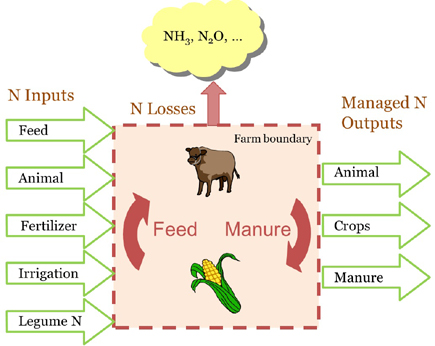Contact us:
Dr. Zifei Liu

Assistant Professor
Biological & Agricultural Engineering
Kansas State University
043 Seaton Hall
Manhattan, KS 66506
Email: Zifeiliu@ksu.edu
Phone: 785-532-3587
Fax: 785-532-5825
Nutrients and Waste Management

Waste Management
Animal manure is one important source of air pollutants. Producers face challenges associated with manure accumulation, storage and disposal. Proper waste management is needed to control odor and dust; to prevent waste from impacting water quality; and to recycle the nutrients in waste.
- Nutrient management plan
- Runoff control
- Seepage control
- Feedlot solid manure collection
- Design and maintenance of storage facility
- Aerobic or anaerobic system
- Land application management of liquid and solid manure
- Crop utilization
- Composting
- Energy conversion: anaerobic digestion, combustion or gasification
Anaerobic Digestion of Livestock Manure
Anaerobic digestion (AD) of livestock manure offers a management option for livestock producers to generate energy from manure. The AD decomposes manure and converts it into a more stable material with reduced odor and pathogens while generating biogas. The primary component of the biogas is methane (CH4), which is a greenhouse gas (GHG) if released into air, but also could be a promising source of energy if captured. The biogas generated from AD can be burned directly for on farm applications (e.g., producing hot water or heat to maintain temperature of the digester), or be used to fuel generators to produce electricity. The digested manure has nutrient value as fertilizer. Dairy based AD can have the potential added benefit of reusing digested fibers for bedding.
Even though AD is a century-old process, the technology is still evolving to adapt the process successfully on the commercial scale for producing energy. U.S. Environmental Protection Agency (EPA) estimated that AD systems are technically feasible at more than 8,000 U.S. dairy and swine facilities (AgSTAR, 2010). However, only 3% of these facilities currently have operational AD systems and failures of AD systems have been reported. One of the main reasons for failures was inadequate management of the system. A small mistake in maintenance can result in a significant decline in biogas production and require months to correct. Other reasons include excessive operating costs and unreliable market for biogas. Recently, interest in AD of livestock manure has been renewed with evolving market for “carbon credit” as well as biogas energy. Both financial support from government and the number of designers available for service in the U.S. has increased significantly.
A cooperative effort among the U.S. Departments of Agriculture, Energy and the EPA to promote bio-gas projects is known as the AgSTAR. The Program offers a variety of tools, resources, and events to increase the use of AD systems. It is the premier U.S. resource for information and assistance with regard to AD of livestock manure. There are multiple grant and cost-share programs available for farm operators who are interested in AD. For detailed information on funding programs, see the AgSTAR funding database, Funding On-Farm Biogas Recovery Systems: A Guide to Federal and State Resources (http://www.epa.gov/agstar/tools/funding/index.html) and the factsheet Funding Programs for Developing Anaerobic Digestion Systems (http://www.epa.gov/agstar/documents/agstar_federal_incentives.pdf).
Composting Animal Manure
Managing manure is a reality for animal agriculture. Manure can be stored with minimum effort in a passive system or a managed composting system. Composting manure changes the quality of manure, but composting may involve more management and costs than a passive storage system. The decision to compost can be a solution to other management problems, and the benefits of composting may compensate livestock producers for the additional costs and efforts. The benefits of composting include less odor, flies, weed seeds, and pathogens in waste, and less amount of waste. In addition, finished compost makes excellent fertilizers and soil amendments, which can improve soil health, fertility, and water-holding capacity. Reasons for a livestock producer to consider composting are summarized in Table 1.
Table 1. Reasons for composting
|
Management problems |
Benefits of composting manure |
|
Manure has fly, insect, and pathogen problems. |
The heat from composting will kill insect eggs, larvae, and pathogens. Flies can’t breed in compost. |
|
Neighbors complain about smells from the manure storage. |
Composting reduces odor.
|
|
Manure needs to be transported for long distance; or manure is too heavy and wet to spread easily. |
Composting reduces the volume and density of manure. Finished compost is drier, and thus is easier to transport and spread. |
|
Weed seeds in the manure become a problem for raw manure land application. |
The heat from composting will kill most weed seeds. |
|
Neighbors complain about smells from land applied raw manure. |
Land applied compost will have little to no odor. |
|
There is not enough cropland to spread all the manure,and there is a local value-added market such as garden centers, landscaping companies, or golf courses. |
Compost can be sold or used on other farms. It is generally more “consumer friendly” and preferred by commercial horticulture. |
|
There is a need to meet environmental goals or permit requirements for nutrient balance. |
Composting can reduce pollution and could be a useful tool in nutrient management plan. |
|
The cost of rendering becomes prohibitive. |
Composting can assist in carcass disposal. |